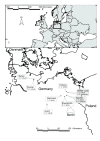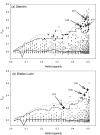Genetic population structure of sympatric and allopatric populations of Baltic ciscoes (Coregonus albula complex, Teleostei, Coregonidae)
- PMID: 20350300
- PMCID: PMC2853541
- DOI: 10.1186/1471-2148-10-85
Genetic population structure of sympatric and allopatric populations of Baltic ciscoes (Coregonus albula complex, Teleostei, Coregonidae)
Abstract
Background: Teleost fishes of the Coregonidae are good model systems for studying postglacial evolution, adaptive radiation and ecological speciation. Of particular interest is whether the repeated occurrence of sympatric species pairs results from in-situ divergence from a single lineage or from multiple invasions of one or more different lineages. Here, we analysed the genetic structure of Baltic ciscoes (Coregonus albula complex), examining 271 individuals from 8 lakes in northern Germany using 1244 polymorphic AFLP loci. Six lakes had only one population of C. albula while the remaining two lakes had C. albula as well as a sympatric species (C. lucinensis or C. fontanae).
Results: AFLP demonstrated a significant population structure (Bayesian thetaB = 0.22). Lower differentiation between allopatric (thetaB = 0.028) than sympatric (0.063-0.083) populations contradicts the hypothesis of a sympatric origin of taxa, and there was little evidence for stocking or ongoing hybridization. Genome scans found only three loci that appeared to be under selection in both sympatric population pairs, suggesting a low probability of similar mechanisms of ecological segregation. However, removal of all non-neutral loci decreased the genetic distance between sympatric pairs, suggesting recent adaptive divergence at a few loci. Sympatric pairs in the two lakes were genetically distinct from the six other C. albula populations, suggesting introgression from another lineage may have influenced these two lakes. This was supported by an analysis of isolation-by-distance, where the drift-gene flow equilibrium observed among allopatric populations was disrupted when the sympatric pairs were included.
Conclusions: While the population genetic data alone can not unambiguously uncover the mode of speciation, our data indicate that multiple lineages may be responsible for the complex patterns typically observed in Coregonus. Relative differences within and among lakes raises the possibility that multiple lineages may be present in northern Germany, thus understanding the postglacial evolution and speciation in the C. albula complex requires a large-scale phylogenetic analysis of several potential founder lineages.
Figures




References
-
- Schluter D. Ecological speciation in postglacial fishes. Philosophical Transactions of the Royal Society of London Series B-Biological Sciences. 1996;351:807–814. doi: 10.1098/rstb.1996.0075. - DOI
-
- Taylor EB. Species pairs of north temperate freshwater fishes: Evolution, taxonomy, and conservation. Rev Fish Biol Fish. 1999;9:299–324. doi: 10.1023/A:1008955229420. - DOI
-
- Schluter D. The ecology of adaptive radiation. Oxford: Oxford University Press; 2000.
Publication types
MeSH terms
LinkOut - more resources
Full Text Sources

